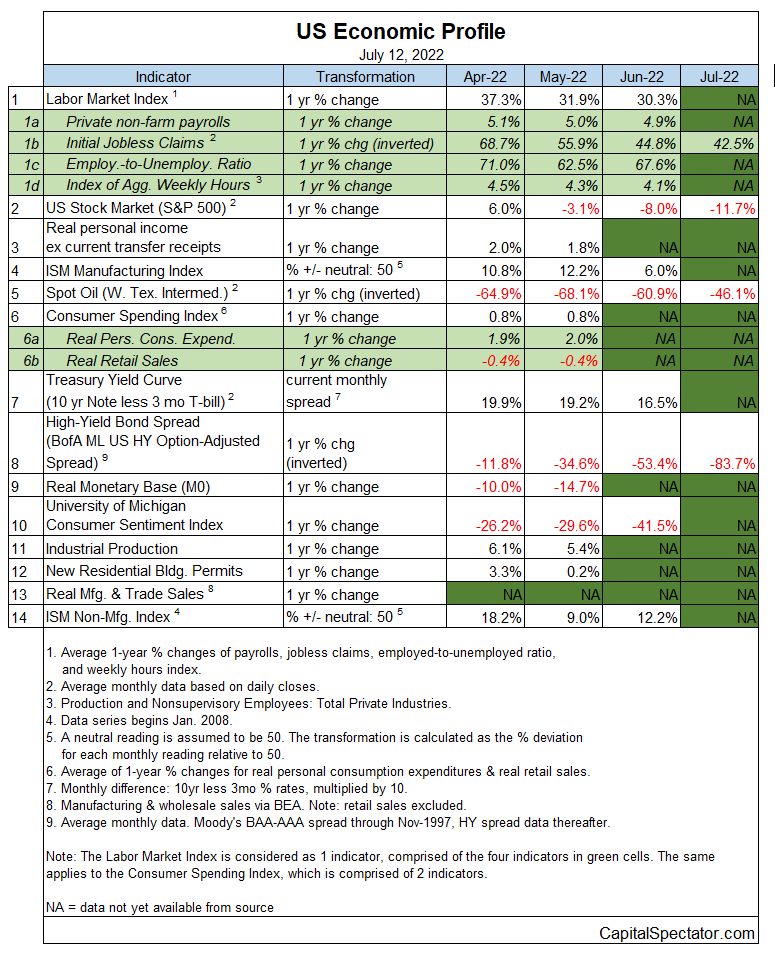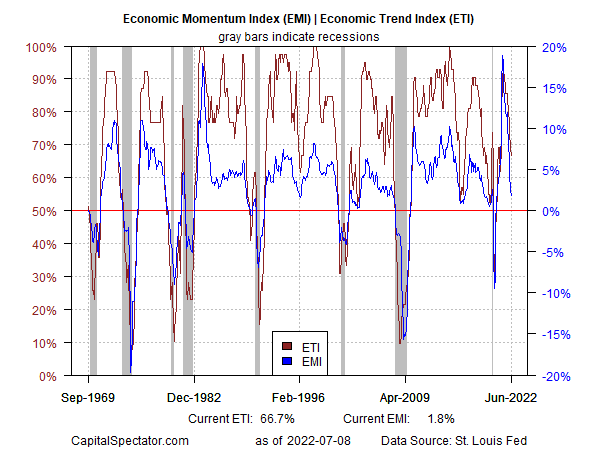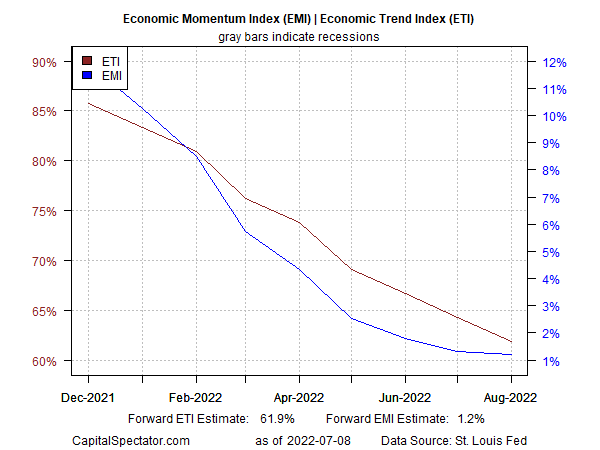Recession risk is rising, which inevitably leads to a discussion and debate about what exactly defines such an event. There’s no single definitive rule, at least nothing that can be easily summarized that’s also widely accepted by economists. But there are many theories. Ergo, it’s easy to become confused as you slip down this rabbit hole.
Fortunately, there’s an obvious starting point, albeit one that’s only a half solution. NBER is widely admired as the gold standard for identifying the start and end dates of US economic contractions. No serious analyst questions these dates. The challenge is that the public announcement of these dates arrives with a lag, sometimes a lengthy one. That’s useful from an academic standpoint in that the NBER never revises its business-cycle-dating announcements. As a practical tool in real time, however, it’s worthless.
That’s where the fun begins when investors and markets attempt to evaluate recession risk in real time. As even a casual reader of economic news surely recognizes, the rules of thumb and estimates on this front range from the reasonable to the ludicrous. Fortunately, there’s an obvious (or at least an arguably obvious) first step in pursuit of a statistical robust and relatively timely evaluation.
In my weekly updates of the US Business Cycle Risk Report I start with the NBER standard, namely, using this historical data as the basis for modeling the economy in real time for nowcasting recession risk. There are many ways to do this, but I’m convinced that tapping into a diversified mix of financial and economic indicators is superior to cherry picking a handful of data sets. Even worse is the popular approach of focusing on one silver-bullet indicator. Even if a particular indicator has shown a high degree of accuracy in the past, you’re never quite sure if it will fail this time. And let’s be honest: Every indicator fails at some point. The good news is that they don’t all fail at once and so you can boost your analytical confidence by using a relatively wide set of numbers that collectively capture the lion’s share of economic volatility.
Here’s my preferred data set. I explain the reasoning in my book Nowcasting The Business Cycle. The basic idea is that this list covers a bases in terms of capturing most of the key variables that influence the economy’s ebb and flow. Minds will differ on the specifics, but after smoothing out some of the noise via econometric techniques, there’s not likely to be much difference between the quasi signal from this group vs. your version of how to profile the macro trend via multiple indicators.

The primary goal is to model recession risk that’s informed by NBER’s business cycle dates and then mapping that history to the indicators listed above. The output is summarized by a pair of proprietary business-cycle indicators I update weekly in the newsletter: Economic Trend Index (ETI) and Economic Momentum Index (EMI). The current update through July shows that economic activity continues to slow but is not yet at the point of falling into recession (as of June). (Tipping points for ETI and EMI are 50% and 0%, respectively.)

Note that some of the indicators in the table above haven’t yet been updated and so I fill in the missing data points with econometric modeling. History suggests the procedure I use (outlined in my book and in the newsletter) works rather well in anticipating what the actual data will show (once it arrives). It’s not perfect, but it’s usually close. The reason? The modeling is only trying to guesstimate some of the numbers, using the available ones as guidance, and on a smoothed basis.
We can look (slightly) ahead to the immediate future and only lose a small degree of confidence in the overall risk assessment through a system of forward-estimate modeling. I’m comfortable looking ahead one to two months. Studying the record tells me that this modest forward window of estimating ETI and EMI is reliable, most of the time. On that score, the current forward estimates for ETI and EMI through August suggest that an NBER-defined recession won’t start next month.

Note, too, that EMI’s forward estimate for August hints at the possibility that the slowdown in growth may begin to stabilize next month. This is preliminary and so it could change, but perhaps this is a glimmer that a new recession isn’t fate. Monitoring how these estimates evolves in the weeks ahead is on the short list of my business-cycle analytics at the moment.
Looking much beyond the next month or two is tempting, but that’s a horse of a different color — and one that inevitably comes with a far higher level of risk and uncertainty. All the more so if you’re forecasting a year or two ahead, as some analysts try to do. By contrast, my approach looks for the sweet spot between maximizing confidence in the signal and minimizing the noise. For most recession estimates you have to choose one or the other. My approach sidesteps that high-risk choice. As I see it, this is the first step in developing high-confidence estimates of recession risk in real time.
Which stock should you buy in your very next trade?
With valuations skyrocketing in 2024, many investors are uneasy putting more money into stocks. Unsure where to invest next? Get access to our proven portfolios and discover high-potential opportunities.
In 2024 alone, ProPicks AI identified 2 stocks that surged over 150%, 4 additional stocks that leaped over 30%, and 3 more that climbed over 25%. That's an impressive track record.
With portfolios tailored for Dow stocks, S&P stocks, Tech stocks, and Mid Cap stocks, you can explore various wealth-building strategies.
